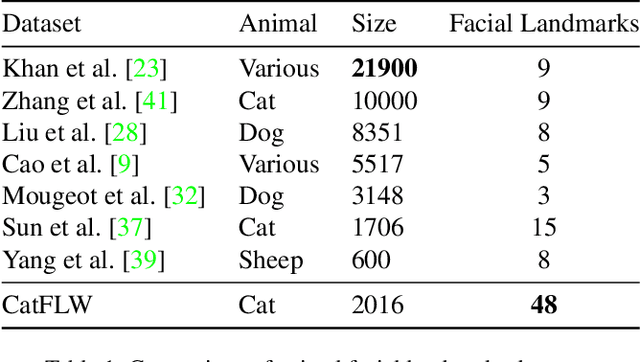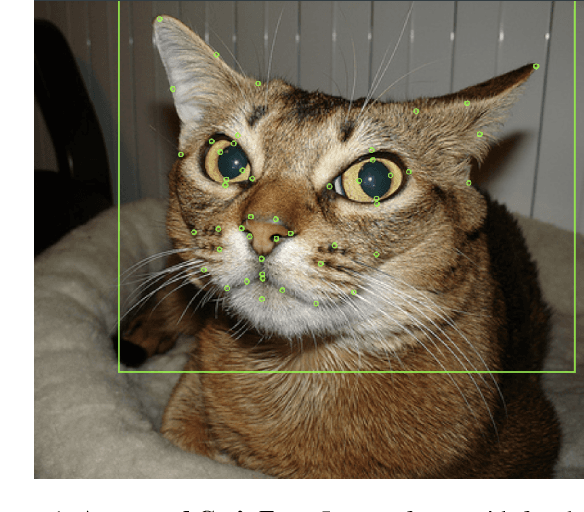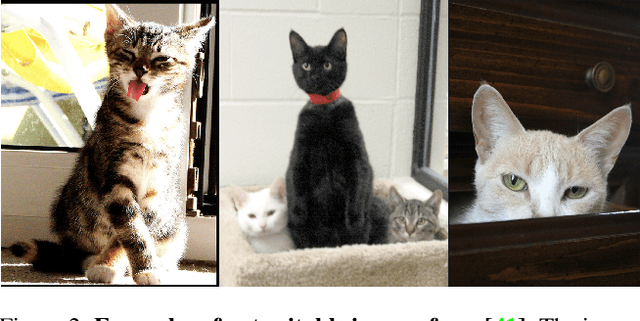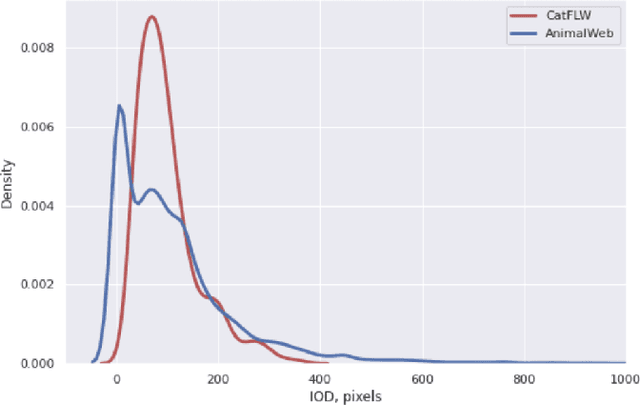Nareed Farhat
DogFLW: Dog Facial Landmarks in the Wild Dataset
May 19, 2024Abstract:Affective computing for animals is a rapidly expanding research area that is going deeper than automated movement tracking to address animal internal states, like pain and emotions. Facial expressions can serve to communicate information about these states in mammals. However, unlike human-related studies, there is a significant shortage of datasets that would enable the automated analysis of animal facial expressions. Inspired by the recently introduced Cat Facial Landmarks in the Wild dataset, presenting cat faces annotated with 48 facial anatomy-based landmarks, in this paper, we develop an analogous dataset containing 3,274 annotated images of dogs. Our dataset is based on a scheme of 46 facial anatomy-based landmarks. The DogFLW dataset is available from the corresponding author upon a reasonable request.
Digitally-Enhanced Dog Behavioral Testing: Getting Help from the Machine
Jul 26, 2023Abstract:The assessment of behavioral traits in dogs is a well-studied challenge due to its many practical applications such as selection for breeding, prediction of working aptitude, chances of being adopted, etc. Most methods for assessing behavioral traits are questionnaire or observation-based, which require a significant amount of time, effort and expertise. In addition, these methods are also susceptible to subjectivity and bias, making them less reliable. In this study, we proposed an automated computational approach that may provide a more objective, robust and resource-efficient alternative to current solutions. Using part of a Stranger Test protocol, we tested n=53 dogs for their response to the presence and benign actions of a stranger. Dog coping styles were scored by three experts. Moreover, data were collected from their handlers using the Canine Behavioral Assessment and Research Questionnaire (C-BARQ). An unsupervised clustering of the dogs' trajectories revealed two main clusters showing a significant difference in the stranger-directed fear C-BARQ factor, as well as a good separation between (sufficiently) relaxed dogs and dogs with excessive behaviors towards strangers based on expert scoring. Based on the clustering, we obtained a machine learning classifier for expert scoring of coping styles towards strangers, which reached an accuracy of 78%. We also obtained a regression model predicting C-BARQ factor scores with varying performance, the best being Owner-Directed Aggression (with a mean average error of 0.108) and Excitability (with a mean square error of 0.032). This case study demonstrates a novel paradigm of digitally enhanced canine behavioral testing.
CatFLW: Cat Facial Landmarks in the Wild Dataset
May 07, 2023



Abstract:Animal affective computing is a quickly growing field of research, where only recently first efforts to go beyond animal tracking into recognizing their internal states, such as pain and emotions, have emerged. In most mammals, facial expressions are an important channel for communicating information about these states. However, unlike the human domain, there is an acute lack of datasets that make automation of facial analysis of animals feasible. This paper aims to fill this gap by presenting a dataset called Cat Facial Landmarks in the Wild (CatFLW) which contains 2016 images of cat faces in different environments and conditions, annotated with 48 facial landmarks specifically chosen for their relationship with underlying musculature, and relevance to cat-specific facial Action Units (CatFACS). To the best of our knowledge, this dataset has the largest amount of cat facial landmarks available. In addition, we describe a semi-supervised (human-in-the-loop) method of annotating images with landmarks, used for creating this dataset, which significantly reduces the annotation time and could be used for creating similar datasets for other animals. The dataset is available on request.
 Add to Chrome
Add to Chrome Add to Firefox
Add to Firefox Add to Edge
Add to Edge